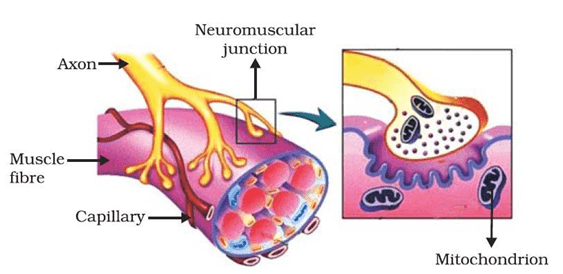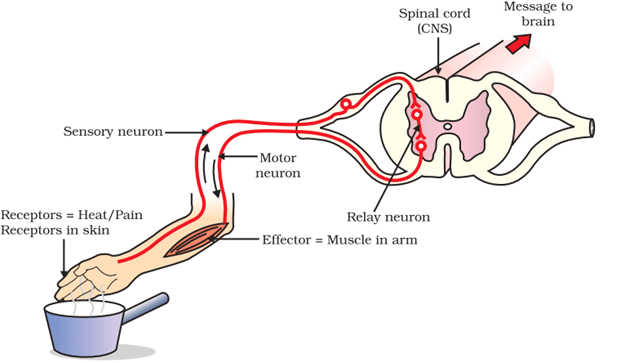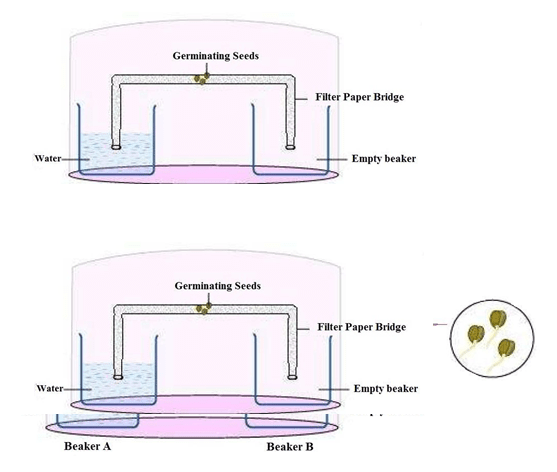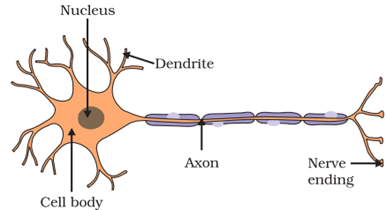NCERT Solutions for Class 10 Science Chapter 6 Control and Coordination latest edition includes answers of intext & exercise questions. All these NCERT solutions are prepared by expert teachers with detailed explanations of every important topic. It is important for the students to go through these NCERT solutions to get knowledge of the type of questions asked in the Control and Coordination chapter.
NCERT Solutions for Class 10 Science Chapter 6 Intext Questions
Page no. 105
Question 1: What is the difference between a reflex action and walking?
Answer: A reflex action is a rapid, automatic response to a stimulus. It does not involve any thinking. For example, we close our eyes immediately when the bright light is focused.
Walking, on the other hand, is a voluntary action. It is under our conscious control.
Question 2: What happens at the synapse between two neurons?
Answer: A very small gap that occurs between the last portion of the axon of one neuron and the dendrite of the other neuron is known as a synapse. It acts as a one-way valve to transmit impulses in one direction only. This one-directional transfer of impulses occurs as the chemicals are produced in only one side of the neuron i.e., the axon’s side. From the axon, the impulses travel across the synapse to the dendrite of the other neuron.

Question 3: Which part of the brain maintains posture and equilibrium of the body?
Answer: Cerebellum, a part of the hindbrain is responsible for maintaining posture and equilibrium of the body.
Question 4: How do we detect the smell of an agarbatti (incense stick)?
Answer: The thinking part of our brain is the forebrain. It has separate areas that are specialized for hearing, smelling, sight, taste, touch, etc. The forebrain also has regions that collect information or impulses from the various receptors. When the smell of an incense stick reaches us, our forebrain detects it. Then, the forebrain interprets it by putting it together with the information received from other receptors and also with the information already stored in the brain.
Question 5: What is the role of the brain in reflex action?
Answer: Reflex actions are sudden responses, which do not involve any thinking. For example, when we touch a hot object, we withdraw our hand immediately without thinking as thinking may take time which would be enough to get us burnt. The sensory nerves that detect the heat are connected to the nerves that move the muscles of the hand. Such a connection of detecting the signal from the nerves (input) and responding to it quickly (output) is called a reflex arc. The reflex arc connections present between the input and output nerves − meet in a bundle in the spinal cord.
Reflex arcs are formed in the spinal cord and the information (input) reaches the brain. The brain is only aware of the signal and the response that has taken place. However, the brain has no role to play in the creation of the response.

Page Number: 108
Question 1: What are plant hormones?
Answer: Plant hormones or phytohormones are naturally occurring organic substances. These are synthesized in one part of the plant body (in minute quantities) and are translocated to other parts when required. The five major types of phytohormones are auxins, gibberellins, cytokinins, abscisic acid and ethylene.
- Gibberellins help in the growth of the stem.
- Auxins help in the growth of the stem.
- Cytokinins promote cell division.
- Abscisic acid is one example of a hormone that inhibits growth.
Question 2: How is the movement of leaves of the sensitive plant different from the movement of a shoot towards light?
Answer: The movement of leaves of the sensitive plant, Mimosa pudica or “touch me not”, occurs in response to touch or contact stimuli. This is done by plant cells by changing the amount of water in leaves. This movement is independent of growth.
The movement of shoot towards light is known as phototropism. This type of movement is directional and is growth dependent.
Question 3: Give an example of a plant hormone that promotes growth.
Answer: Examples of plant growth hormones:
- Gibberellins help in the growth of the stem.
- Auxins help in the growth of the stem.
- Cytokinins promote cell division.
Question 4: How do auxins promote the growth of a tendril around a support?
Answer: Auxins are plant hormones that help in the growth of a tendril around a support. When a tendril touches a support, the auxins concentrate on the side of the tendril that’s not touching the support. This causes the cells on that side to grow longer. Since one side grows longer than the other, the tendril starts to curl around the support. This curling action helps the plant climb and support itself.
Question 5: Design an experiment to demonstrate hydrotropism.
Answer: Take two small beakers and label them as A and B. Fill beaker A with water. Now make a cylindrical-shaped roll from filter paper and keep it as a bridge between beaker A and beaker B, as shown in the figure. Attach a few germinating seeds in the middle of the filter paper bridge. Now, cover the entire set-up with a transparent plastic container so that the moisture is retained.
Observation: The roots of the germinating seeds will grow towards beaker A. This experiment demonstrates the phenomenon of hydrotropism

Page Number: 111
Question 1: How does chemical coordination take place in animals?
Answer: Chemical coordination takes place in animals with the help of hormones. Hormone is the chemical messenger that regulates the physiological processes in living organisms. It is secreted by endocrine glands. Hormones travel in the blood to target organs or cells and regulate various body functions like growth, metabolism, and stress response.
Question 2: Why is the use of iodised salt advisable?
Answer: Iodine stimulates the thyroid gland to produce thyroxin hormone. It regulates carbohydrate, fat, and protein metabolism in our body. Deficiency of this hormone results in the enlargement of the thyroid gland. This can lead to goitre, a disease characterized by swollen neck. Therefore, iodised salt is advised for normal functioning of the thyroid gland.
Question 3: How does our body respond when adrenaline is secreted into the blood?
Answer: Adrenalin is a hormone secreted by the adrenal glands in case of any danger or emergency or any kinds of stress. It is secreted directly into the blood and is transported to different parts of the body. When secreted in large amounts, it speeds up the heartbeat and hence supplies more oxygen to the muscles. The breathing rate also increases due to the contractions of the diaphragm and rib muscles. It also increases blood pressure. All these responses enable the body to deal with any stress or emergency.
Question 4: Why are some patients of diabetes treated by giving injections of insulin?
Answer: Diabetes is a disease in which the level of sugar in the blood is too high. Insulin, a hormone secreted by the pancreas, helps in regulating the blood sugar levels. This is the reason why diabetic patients are treated by giving injections of insulin
NCERT Solutions for Class 10 Science Chapter 6 Exercise Questions
Question 1: Which of the following is a plant hormone?
(a) Insulin
(b) Thyroxin
(c) Oestrogen
(d) Cytokinin
Answer: (d) Cytokinin is a plant hormone.
Question 2: The gap between two neurons is called a
(a) dendrite.
(b) synapse.
(c) axon.
(d) impulse.
Answer: (b) synapse.
Question 3: The brain is responsible for
(a) thinking.
(b) regulating the heart-beat.
(c) balancing the body.
(d) all of the above.
Answer: (d) all of the above.
The brain is responsible for thinking, regulating the heartbeat and balancing the body.
Question 4: What is the function of receptors in our body? Think of situations where receptors do not work properly. What problems are likely to arise?
Answer: Receptors are sensory structures (organs/tissues or cells) present all over the body. The receptors are either grouped in case of eye or ear or scattered in case of skin.
Functions of receptors:
- They sense the external stimuli such as heat or pain.
- They also trigger an impulse in the sensory neuron which sends message to the spinal cord.
When the receptors are damaged, the external stimuli transferring signals to the brain are not felt. For example, in the case of damaged receptors, if we accidentally touch any hot object, then our hands might get burnt as damaged receptors cannot perceive the external stimuli of heat and pain.
Question 5: Draw the structure of a neuron and explain its function.
Answer: Neurons are the functional units of the nervous system. The three main parts of a neuron are axon, dendrite and cell body.
Functions of the three parts of a neuron:
- Axon: It conducts messages away from the cell body.
- Dendrite: It receives information from axon of another cell and conducts the messages towards the cell body.
- Cell body: It contains nucleus, mitochondria, and other organelles. It is mainly concerned with the maintenance and growth.

Question 6: How does phototropism occur in plants?
Answer: The movement of the plant in response to light is called phototropism. Stem shows positive phototropism as follows:
When growing plants detect light, a hormone called auxin, synthesized at the shoot tip, helps the cells to grow longer. When light is coming from one side of the plant, auxin diffuses towards the shady side of the shoot. This concentration of auxin stimulates the cells to grow longer on the side of the shoot which is away from light. Thus, the plant appears to bend towards light.
Question 7: Which signals will get disrupted in case of a spinal cord injury?
Answer: The reflex arc connections between the input and output nerves meet in a bundle in the spinal cord. In fact, nerves from all over the body meet in a bundle in the spinal cord on their way to the brain. In case of any injury to the spinal cord, the signals coming from the nerves as well as the signals coming to the receptors will be disrupted.
Question 8: How does chemical coordination occur in plants?
Answer: Animals have a nervous system for controlling and coordinating the activities of the body. But plants have neither a nervous system nor muscles. Plants respond to stimuli by showing movements. The growth, development, and responses to the environment in plants are controlled and coordinated by a special class of chemical substances known as hormones. These hormones are produced in one part of the plant body and are translocated to other needy parts. For example, a hormone produced in roots is translocated to other parts when required. The five major types of phytohormone are auxins, gibberellins, cytokinins, abscisic acid, and ethylene. These phytohormones are either growth promoters (such as auxins, gibberellins, cytokinins, and ethylene) or growth inhibitors such as abscisic acid.
Question 9: What is the need for a system of control and coordination in an organism?
Answer: The maintenance of the body functions in response to changes in the body by working together of various integrated body systems is known as coordination. All the movements that occur in response to stimuli are carefully coordinated and controlled. In animals, the control and coordination movements are provided by nervous and muscular systems. The nervous system sends messages to and away from the brain. The spinal cord plays an important role in the relay of messages. In the absence of this system of control and coordination, our body will not be able to function properly. For example, when we accidentally touch a hot utensil, we immediately withdraw our hand. In the absence of nerve transmission, we will not withdraw our hand and may get burnt.
Question 10: How are involuntary actions and reflex actions different from each other?
Answer:
| Reflex actions | Involuntary actions |
| 1. Rapid automatic responses to a stimulus without the conscious involvement of the brain | 1. Occurs without the consciousness of an organism |
| 2. Controlled by spinal cord | 2. Controlled by mid brain or medulla oblongata |
| 3. Very quick and instantaneous | 3. Relatively slower |
| 4. May involve any muscle or a gland | 4. Involves only smooth muscles |
| 5. Can be conditioned | 5. Cannot be influenced by external conditioning |
| Examples: Blinking of eyes, salivation | Examples: Beating of heart, blood circulation |
Question 11: Compare and contrast nervous and hormonal mechanisms for control and coordination in animals.
Answer:
| Nervous control | Hormonal Control |
| It is consist of nerve impulses between PNS, CNS and Brain. | It consists of endocrine system which secretes hormones directly into blood. |
| Here response time is very short. | Here response time is very long. |
| Nerve impulses are not specific in their action. | Each hormone has specific actions. |
| The flow of information is rapid. | The flow of information is very slow. |
Question 12: What is the difference between the manner in which movement takes place in a sensitive plant and the movement in our legs?
Answer:
| Movement in sensitive plants | Movement in our legs |
| The movement in a sensitive plant is a response to stimulus (touch) which is an involuntary action. | Movement in our legs is a voluntary action. |
| No special tissue is there for the transfer of information | A complete system CNS and PNS is there for the information exchange. |
| Plant cells do not have specialized protein for movements. | Animal cells have specialized protein which help muscles to contract. |